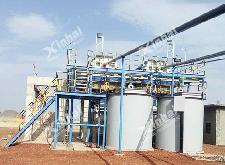

Warm Tip: If you want to know more details about equipment, solutions, etc, please click the button below for free consultation, or leave your requirements!
In general, micro-fine gold ore has the fine disseminated grain size, and usually contain a variety of complex components that hinder gold extraction, such as micro-fine gold ore with arsenic, sulfur and carbon. It is very difficult to achieve the ideal effect by the simple gold extraction methods when separating these gold ores. we will explain the difficulties and solutions of extraction methods of these three kinds of gold ore.
the carbonaceous substances in gold mines will absorb cyanide during the cyanidation leaching, which reduces the reaction between cyanide and gold, and consumes the reagents. In the froth flotation process, the carbonaceous matter is easy to float and can adsorb the flotation reagents at the same time, which increases the economic cost.
In order to avoid the disturbing effect of carbon content in the gold ore processing, we can oxidizing roasting or priority floating carbon processing methods. After the decarburization the processing of micro-fine gold ore is relatively simple. Due to the uneven disseminated micro-fine gold ore, we need a reasonable grinding process to improve the grain size of mineral by reducing grinding operation. We can adopt the preferential flotation method to remove part of the gangue mineral, the enriched carbon content in the flotation concentrate can be treated with roasting process, then cyanide leaching method can be used to process the gold, which is beneficial to obtain better economic indicators.
The micro-fine gold ore containing sulphur is a relatively common type of gold ore. For this kind of gold ore, the fine gold or sub-microscopic gold exists in pyrite as enveloping or disseminated. Although the pyrite is a mineral with better floatability, it is difficult to achieve monomer dissociation even reducing the grinding fineness, so the recovery is very difficult.
For such minerals, we can adopt multi-stage grinding, multi-separation process. Adopting the roughing in the case of coarser mineral granularity, using the sodium carbonate, sodium silicate, copper sulfate, butyl xanthate as the reagent combination, then adopting closed-circuit flotation based on the condition of roughing, so that the gold concentrate with ideal grade and recovery rate can be obtained.
Arsenic often exists in arsenopyrite for the micro-fine gold ore containing arsenic, and the arsenopyrite exists closely with the micro-fine gold ore, and the particles are not uniform, most of sulfide is easy to be dissociated.
In addition, the difficulty lies in the following aspects: First, some of the gold ore materials have extremely fine grain size, most of which are less than 0.01mm, the gold mineral and the gold-loaded mineral are difficult to achieve monomer separation, which is easy to be abandoned along with the tailings. Second, the mineral particle size is uneven,some coarse-grained gold-loaded pyrite has many cracks, which cannot be fine grinding, and is easy to rupture thus leading to the loss of gold ore; Third,there are many layered silicate minerals such as white mica, biotite and clay minerals in the original ore, which affect the flotation of gold ore.
Because the size of gold is very fine, and the carrier minerals of gold are mainly pyrite, arsenopyrite or other minerals, most of which are of extremely uneven thickness, and can accept the segmented dissociation pattern, so that the gold ore can be effectively and properly dissociated from other minerals, which can be handled by segmentation distributary component velocity flotation process. Because of the difference in the particle size of gold ore and the floatability of gangue mineral, the semi-closed and semi-open process can be adopted. Segmentation distributary component velocity separation can enlarge the floatability difference between gold ore and gangue, so that the gold can be accepted efficiently. Besides, using the strong collectors, such as BK903G, BK302A or MA to improve the flotation effect of micro-fine gold particles and gold-bearing substances. What’s more, reducing the amount of water glass, so that the tailings deposition speed up, and reducing the use of polymer flocculant. According to the request of ore nature and new technology, the method of adding medicament in sections can also be adopted to improve the effect of reagents on minerals.
Above, we have described three kinds of methods about micro-fine gold ore processing. In practical application, the experiments should carry out the mineral processing test according to the ore properties, so as to combine the gold ore processing method with the ore and achieve the double-effect results of economic benefit and mineral recovery.
Last: 7 Factors That Influences the Froth Flotation Effect
Next: 4 Ways to Teach You How to Improve the Index of Extraction of Tin Ore
13 Working Principle of Cyanide Leaching of Gold
 0
0
 9332
9332
2What Are The Gravity Separation Methods Used To Process Gold I?
 5
5
 4136
4136
33 Common Questions about Gold Flotation Processing Technology
 2
2
 3638
3638


What Are the Differences Between CIP and CIL?
 11382
11382
 0
0